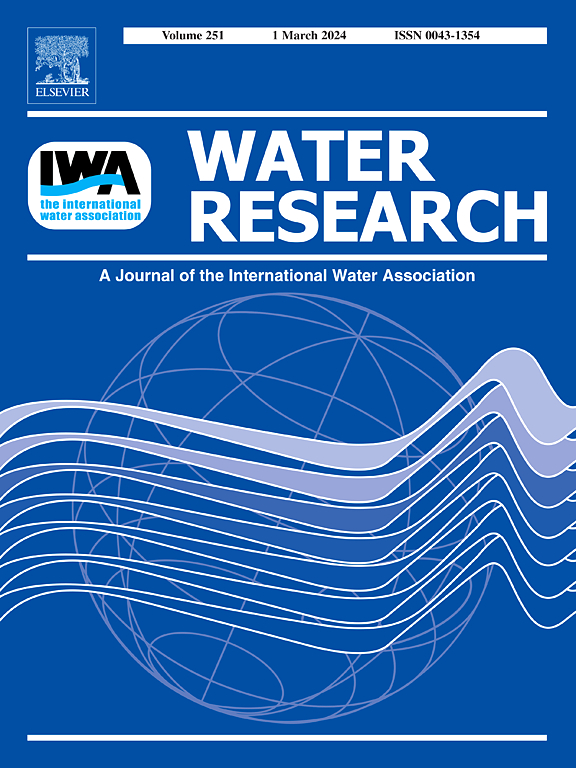草甘膦和氨基甲基膦酸在美国纽约州地表水、饮用水、废水和其他水种中的出现和分布
IF 12.4
1区 环境科学与生态学
Q1 ENGINEERING, ENVIRONMENTAL
引用次数: 0
摘要
在过去的几十年里,草甘膦除草剂在世界范围内被广泛使用,引起了人们对其在水生环境中出现的担忧。在这项研究中,我们调查了2023-2024年间在美国纽约州采集的229种不同类型水样中的草甘膦及其降解产物氨基甲基膦酸(AMPA)。不同水类型间草甘膦几何平均浓度的变化顺序为:雨水径流(112 ng/L) >;废水(42.5 ng/L) >;污水(14.1 ng/L) >;河水(10.3 ng/L) >;雨水(9.61 ng/L) >;湖水(4.57 ng/L)。在饮用水和游泳池水中很少发现草甘膦。分析物的成分分布在不同的水类型中有所不同,表明多种来源和过程导致了它们的污染。两种分析物的浓度在雨水、河水和雨水径流中呈显著相关,表明AMPA主要来源于草甘膦的降解。在废水处理中,草甘膦和AMPA的去除率为负(≤-186%),这意味着这些化学物质在处理过程中形成和释放。草甘膦的计算风险商为<;0.1为>;97%的地表水样本被分析,表明生态风险最小。本研究为评估水生环境中草甘膦的来源和风险提供了基线信息。本文章由计算机程序翻译,如有差异,请以英文原文为准。


Occurrence and distribution of glyphosate and aminomethylphosphonic acid in surface water, drinking water, wastewater and other water types from New York State, USA
Glyphosate-based herbicides have been extensively used worldwide over the past several decades, raising concerns over their occurrence in aquatic environments. In this study, we determined glyphosate and its degradation product, aminomethylphosphonic acid (AMPA), in 229 water samples of various types collected from New York State, USA, during 2023–2024. The geometric mean concentration of glyphosate varied among water types in the following decreasing order: stormwater runoff (112 ng/L) > wastewater effluent (42.5 ng/L) > wastewater influent (14.1 ng/L) > river water (10.3 ng/L) > rainwater (9.61 ng/L) > lake water (4.57 ng/L). Glyphosate was rarely found in drinking water and swimming pool water. The composition profiles of the analytes varied among different water types, indicating that multiple sources and processes contributed to their contamination. The concentrations of two analytes were significantly correlated in rainwater, river water, and stormwater runoff, indicating that AMPA originated primarily from glyphosate degradation. Glyphosate and AMPA showed negative removal efficiencies (≤ -186 %) in wastewater treatment, which implies formation and release of these chemicals during treatment. The calculated risk quotient of glyphosate was below 0.1 for > 97 % of surface water samples analyzed. This study provides baseline information for the assessment of sources and risks of glyphosate in the aquatic environment.
求助全文
通过发布文献求助,成功后即可免费获取论文全文。
去求助
来源期刊

Water Research
环境科学-工程:环境
CiteScore
20.80
自引率
9.40%
发文量
1307
审稿时长
38 days
期刊介绍:
Water Research, along with its open access companion journal Water Research X, serves as a platform for publishing original research papers covering various aspects of the science and technology related to the anthropogenic water cycle, water quality, and its management worldwide. The audience targeted by the journal comprises biologists, chemical engineers, chemists, civil engineers, environmental engineers, limnologists, and microbiologists. The scope of the journal include:
•Treatment processes for water and wastewaters (municipal, agricultural, industrial, and on-site treatment), including resource recovery and residuals management;
•Urban hydrology including sewer systems, stormwater management, and green infrastructure;
•Drinking water treatment and distribution;
•Potable and non-potable water reuse;
•Sanitation, public health, and risk assessment;
•Anaerobic digestion, solid and hazardous waste management, including source characterization and the effects and control of leachates and gaseous emissions;
•Contaminants (chemical, microbial, anthropogenic particles such as nanoparticles or microplastics) and related water quality sensing, monitoring, fate, and assessment;
•Anthropogenic impacts on inland, tidal, coastal and urban waters, focusing on surface and ground waters, and point and non-point sources of pollution;
•Environmental restoration, linked to surface water, groundwater and groundwater remediation;
•Analysis of the interfaces between sediments and water, and between water and atmosphere, focusing specifically on anthropogenic impacts;
•Mathematical modelling, systems analysis, machine learning, and beneficial use of big data related to the anthropogenic water cycle;
•Socio-economic, policy, and regulations studies.
 求助内容:
求助内容: 应助结果提醒方式:
应助结果提醒方式:


